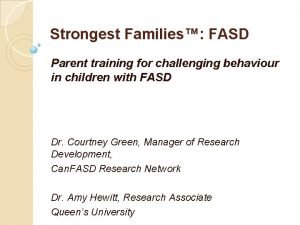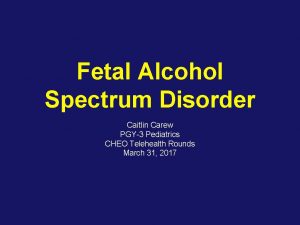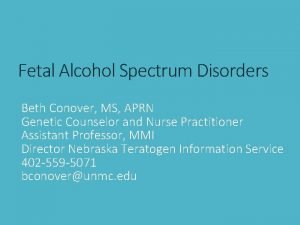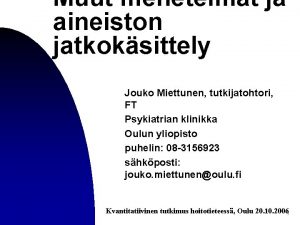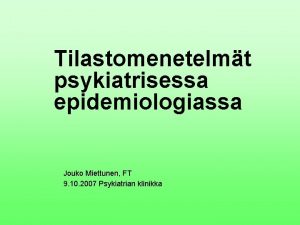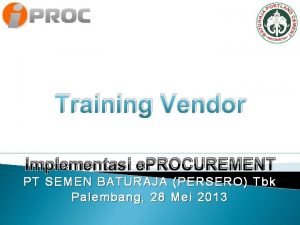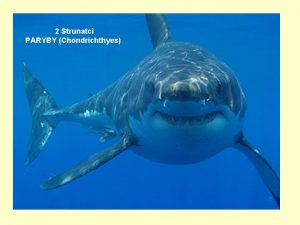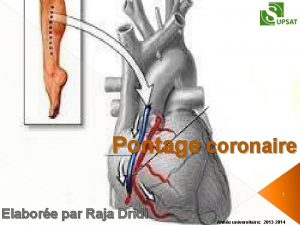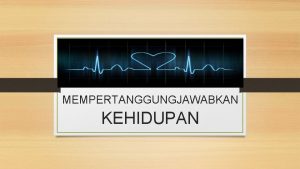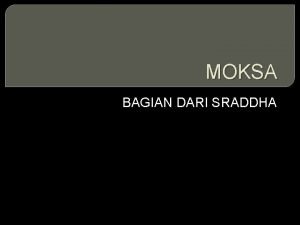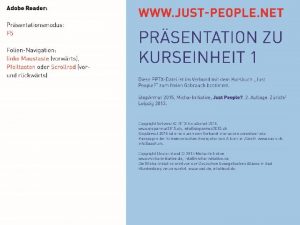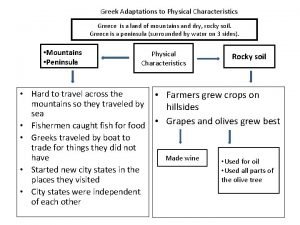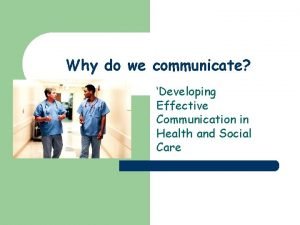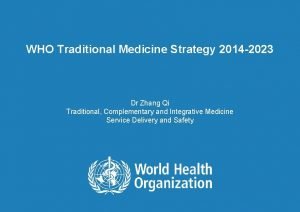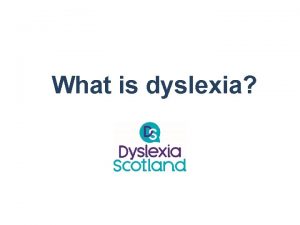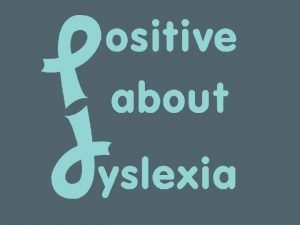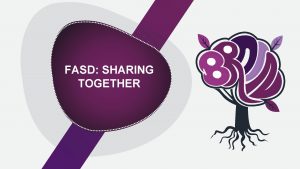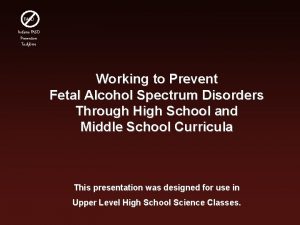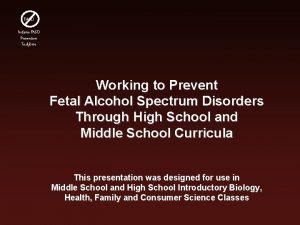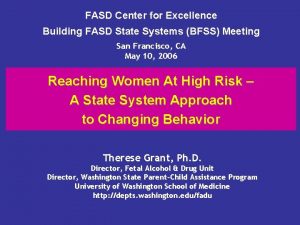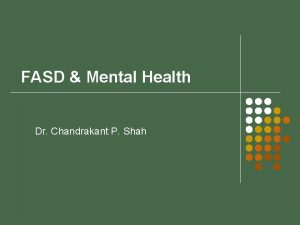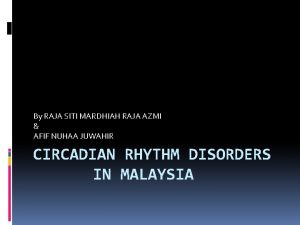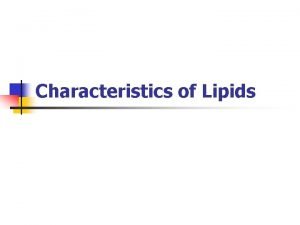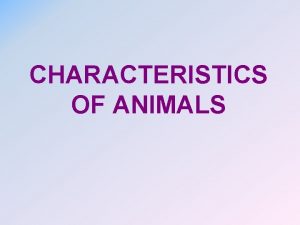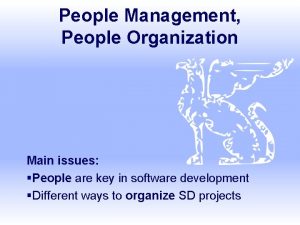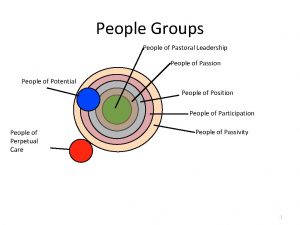FASD Characteristics of people with FASD Dr Raja














![Screening prevalence of ] Fetal alcohol spectrum disorders (FASD) in a region of the Screening prevalence of ] Fetal alcohol spectrum disorders (FASD) in a region of the](https://slidetodoc.com/presentation_image_h2/487308b412efdd3a10070ba1bf57ee6b/image-15.jpg)







































- Slides: 54

FASD: Characteristics of people with FASD Dr Raja Mukherjee Consultant Psychiatrist Lead Clinician FASD Behavioural Clinic Surrey and Borders Partnership NHS trust Honorary Reader University of Salford Raja. mukherjee@sabp. nhs. uk

Diagnostic Terms IOM 1. Fetal Alcohol Syndrome : Confirmed alcohol exposure : • Alcohol Exposure • Facial pattern of Short palpebral fissures < / = 10 percentile, Thin upper lip vermillion, Smooth philtrum • Evidence of pre / postnatal growth retardation • Evidence of Neurocognitive deficits 2 Fetal Alcohol Syndrome: No confirmed alcohol exposure • As above but no alcohol exposure found 3 Partial Fetal Alcohol syndrome: Confirmed Alcohol Exposure • Not all of the above features are present but neurocognitive and some facial features needed 4 Alcohol Related Birth Defect (ARBD) • Confirmed maternal alcohol consumption as well as some but not all of the facial features are present however the behavioural features or structural abnormalities are more pronounced. 5 Alcohol Related Neurodevelopmental Disorder (ARND) • Confirmed maternal alcohol consumption with the absence of growth retardation or facial features and with the neurocognitive features being prominent. Fetal Alcohol Spectrum Disorders • Umbrella term. But changing! 2016 Canadian criteria. DSM V: Neurobehavioral Disorder associated with Prenatal Alcohol Exposure (NDPAE) Summary of diagnostic categies and methods. (Stratton 1996 Hoyme 2005, CANFASD 2016, DSM V 2013).

Diagnostic codes met based on descriptions in Chudley 2005 ( number [% of total group]) when applied to Jan 2014 audit (total N=82). Data From UK FASD National clinic (Keble and Mukherjee 2016) IOM Category IOM Number [%] 4 Digit category 4 Digit: Number [%] NDPAE criteria met: Number [%] FAS Alcohol Exposed 10[12. 2] A 10[12. 2) 10 [12. 2] FAS Alcohol unknown 1[1. 2] B 1[1. 2) 0 PFAS 10[12. 2] C 10[12. 2) 10 [12. 2] ARND 52 [64. 2) E/F 52[63. 4) 52 [63. 4] G/H 7[8. 6] 0 Other 2[2. 4) 0 Poss ARND 3[3. 6) Not FASD 6[7. 3) Total of full group met a confirmed FASD diagnosis 73[89. 9) 0 Total of full group met a confirmed FASD diagnosis 73[89. 0] (72[87. 8])

Countries where FASD has been assessed in literature: And shows a similar profile

BRIEF Scores from UK and Canada (Mohamed et al 2018) 90 Global Executive Component (GEC) Metacognition Index (MI) Monitor Organization of Materials Plan/Organize Working Memory Initiate Behavioural Regulation Index (BRI) Emotional Control Shift Inhibit 50 Rai et al. (2016) UK National FASD Clinic 85 80 75 70 65 60 55

Alcohol as a Teratogen

How genetics works Genes Amino Acids Proteins Organs

Abnormal genetics Genes Faulty Amino – Acids coded incorrectly Organs Malformed Incorrect Proteins

How a Teratogen has effect Genes Amino Acids Teratogen e. g. Alcohol Abnormal Proteins


Global prevalence of alcohol consumption in pregnancy Popova et al 2017 Top 5 countries % consumption • Ireland 60. 4 • Belarus 46. 6 • Denmark 45. 8 • UK 41. 3 • Russia 36. 5

Drinking in pregnancy Nykjaer et al 2014 Assessed drinking in pregnancy and before Looked at early physical rather than cognitive Followed up 1153 people Adjusted for smoking More likely to affect size and more likely to be preterm

Pouring task

Prevalence in LAC/ adoption group Prevalence study using 4 digit assessment tool USA, 10 -15/1000 (Astley et al 2002) 30% of ethic minority adopted population thought to have prenatal alcohol exposure (Selwyn and Wijedesa 2011) Data collected 547 foster and adopted children. 156 met criteria FASD (29%) of which 86. 5% undiagnosed (Charnoff 2015) Meta analysis 16% LAC FASD (Popova 2015) Peterborough 55/160(34%) LAC group and 34/45 adoption reports (75%) FASD (Gregory 2015)
![Screening prevalence of Fetal alcohol spectrum disorders FASD in a region of the Screening prevalence of ] Fetal alcohol spectrum disorders (FASD) in a region of the](https://slidetodoc.com/presentation_image_h2/487308b412efdd3a10070ba1bf57ee6b/image-15.jpg)
Screening prevalence of ] Fetal alcohol spectrum disorders (FASD) in a region of the United Kingdom: a population-based birth-cohort study Dr Cheryl Mc. Quire et al Population medicine 2018

Results – Patterns of drinking in pregnancy

Results – FASD Screening Prevalence Method Total FASD prevalence Single imputation 6. 0% Complete case 7. 2% Multiple imputation (MAIN ESTIMATE) 17. 0% (sensitivity analyses 12. 7% – 12. 8%)

Conclusions about risk (not safety) All epidemiology look at safe levels inconclusive and mixed High Levels High Risk Low Levels Low Risk No Alcohol No Risk

Other areas to consider

Other presentations to rule out Genetic Disorders Prematurity Neglect Medication Smoking Illegal drugs • Heroin • Cocaine • Cannabis • others

Overview table: Behnke et al 2013 (Paediatrics)

Environment vs Biology

Parts involved Environmental issues e. g. Attachment Biological insults e. g. Genetic + prenatal / postnatal causes Observed Symptoms

Parts involved Environmental issues e. g. Attachment Biological insults e. g. Genetic + prenatal / postnatal causes Observed Symptoms

Parts involved Environmental issues e. g. Attachment Biological insults e. g. Genetic + prenatal / postnatal causes Observed Symptoms

Psychiatric onion! To coin a phrase! Environmental Influences Vulnerability from function Neurodevelopmental problems

Development of attachment (Schaffer and Emerson) 0 -6 weeks: Asocial; in both social and non social situations will make responses 6 weeks – 7 months: Indiscriminate attachment; Begin to seek social contact but from anyone. By 3 months a preference towards main carer is being established 7 -9 months: Specific attachment; preference for one person established 10 months +: Multiple attachments: Babies begin to develop attachments and can transfer security

Attachment styles Secure Avoidant Ambivalent Disorganised Reactive Adjustment Disorder • Inhibited • Disinhibited http: //www. practicenotes. org/v 19 n 3/identifying. htm

Attachment and PAE/ FASD , Wray, Palod, Mukherjee 7 Studies (2 FASD) 2 FASD ones showed no effect Others with Prenatal alcohol exposure showed mixed findings on attachment with most showing more insecure attachment (disorganised type) irrespective of initial parenting Some improvement with good consistent parenting All had methodological issues None stratified by intellectual level or level of exposure Needs more research

De Schippers 2006: Dutch Study of attachment behaviours • Some attachment behaviour established • Variations in the attachment behaviour seen Schuengel 2007 attachment to parents with Child ID • Attachment behaviour less clear • Percentage children secure attachment lower De Schippers 2008: Observation study Dutch Schools • Secure attachment behaviour less characteristic. • Higher the developmental age the more attachment behaviour seen Rutgers (2007) Attachment and parenting comparing ASD, LD and normal controls, • Parenting not found to be cause of attachment problems in ASD group Attachment and Autism / ID research

Impact of Neglect and ACE Alcohol 2018 Mukherjee, Price, Norgate, Cook

Effects of neglect Romanian study. Being adopted after 6 months shows developmental delays. Even if some catch up seen not as good as those adopted before 6 months. (Rutter et al 1998, Sonuga Barke 2017) Neglect associated with difficulties with behaviour issues, emotional issues, cognitive problems, medical sequelae which remain later in life. (Kauffmann 2009) Overview Bellis 2005 • Romanian study showed significant neglect • Tizzard and Hodges 74 and 77 with lesser levels of neglect showed improvement with no significant cognitive deficits • PTSD common • Effects on myelination and corpus collsum found but never controlled alcohol.

Systematic review of Childhood Trauma and PAE (Price et al 2017) 5 Studies identified Diverse studies with heterogeneous methods Where both, more likely to present with more complex communicatory, cognitive and behavioural issues. Limited by diverse and sometime flawed methodology More systematic evaluation needed

Exploring the impact of Neglect and FASD PAE Both Outcomes Neglect

Exploring the impact of Neglect and FASD PAE Both Outcomes Neglect

Neurodevelopmental outcomes seen ( no significant difference between groups)

Findings Summary Our findings suggest 2 broad conclusions • • That Neurodevelopmental disorders are seen independent of neglect Neglect does not appear to make the neurodevelopmental presentation any worse Limitations • Numbers not huge but does allow analysis • Does not have a group of neglect alone • Does not measure the psychological impact and overlap

Exploring the impact of Neglect and FASD PAE Both Outcomes Neglect

Henry et al 2007 Specialist MDT assessment of children Comparing PAEwith Neglect to neglect alone • PAE + Neglect • • Neglect alone severe neurodevelopmental deficits in language, memory, visual processing, motor skills, and attention greater oppositional/defiant behaviour, • inattention, hyperactivity, impulsivity • social problem Both had been studied but not together Retrospective study 274 children 6 -16 Michigan area

Attachment Summary Limited studies with FASD Where have been done • More likely to be disorganised • Irrespective of parenting Limitations by level of disability Damaged underlying brain means typical attachment not always seen Biology appears to be influenced prenatally and leads to vulnerability that is impacted by experience Not always the parents fault

How do I diagnose it And how do I make sure I don’t miss it : Clinical pathways.

How it presents Mukherjee et al JRSM 2006 Gray and Mukherjee JMHLD 2007

Reasons for referral Growth problems Behavioural issues Learning issues Physical problems

Comorbidity of FASD Svetlana Popova Ph. D*1, 2, 3, 4, Shannon Lange MPH 1, 4, Kevin Shield MHSc 1, 4, Alanna Mihic MSc 2, Albert E. Chudley MD 5, Raja A. S. Mukherjee, Ph. D 6, Dennis Bekmuradov BA 7, and Jürgen Rehm Ph. D 1, 2, 4, 8 The Lancet Jan 5 2016

Main findings 5068 studies identified of which 127 met criteria for inclusion 428 comorbid conditions linked to FASD From 18/22 chapters of ICD 10 Important consideration clinically and research

Co morbidity pooled estimates 1 Conduct disorder Intellectual impairments Language disorders Other mental health disorders

Co morbidity pooled estimates 1 Visual impairments Surgical issues e. g. hernia Hearing issues Other congenital abnormalties

Developmental Divergence by age FASD Non FASD 2 4 6 8 10 12 14 16 18

Diagnostic process

Diagnosis FASD National Clinic process

Comparison between diagnostic Tools Face CDC IOM revised Canadian 4 Digit 10 th percentile PFL and rank 4/5 on lip philtrum 3 rd percentile PFL and rank 4/5 on lip philtrum Growth Pre / post natal growth below 10 th percentile Neurological 1 out of several brain parameters including OFC <10 %, CNS deficits 1 out of l brain parameters including OFC <10 %, CNS deficits 3+ soft hard neurological signs 1 out of several brain parameters including OFC <3 %, CNS deficits Confirmed or unknown Or abnormal structure Alcohol Confirmed or unknown Confirmed to be excessive or unknown

New proposed Criteria DSM V included FASD for first time FAS had been in ICD but not ARND Not main category Condition for more study Neurobehavioural Disorder associated with PAE I (NBD PAE) Effectively ARND 7 Domains

Facial features

Critical periods and facial features Normal Alc–Day 7 Alc–Day 8 Fetus Neonate Modified from Sulik et al. Slides Courtesy of Professor E Riley University of San Diego
 Raja hindi songs
Raja hindi songs Fasd behavior checklist
Fasd behavior checklist Fasd
Fasd Beth conover
Beth conover Nama lain kian santang
Nama lain kian santang Raja hutan menjadi tuan rumah
Raja hutan menjadi tuan rumah Raja krishnamoorthi internship
Raja krishnamoorthi internship Kivilompolon raja-asema
Kivilompolon raja-asema Spss cronbach's alpha
Spss cronbach's alpha Raja giryes
Raja giryes Raja elektrická
Raja elektrická Raja marie antoinette
Raja marie antoinette Reabiliteetti
Reabiliteetti Hukum hammurabi merupakan warisan kebudayaan
Hukum hammurabi merupakan warisan kebudayaan Role of rrrlf in modernisation of libraries
Role of rrrlf in modernisation of libraries Conclusion of raja ram mohan roy
Conclusion of raja ram mohan roy Raja hasan saregamapa 2007
Raja hasan saregamapa 2007 Siapakah lang buana
Siapakah lang buana Dr raja rizwan
Dr raja rizwan Ciri ciri kepimpinan kesukuan di sarawak
Ciri ciri kepimpinan kesukuan di sarawak Dr raja rizwan
Dr raja rizwan Raja mazumder
Raja mazumder The mystic bard of bangladesh paragraph
The mystic bard of bangladesh paragraph Glockenfaçon
Glockenfaçon Travnicka raja
Travnicka raja Doa raja
Doa raja Raja rani vs prem adib
Raja rani vs prem adib Orsó hal
Orsó hal Why did hason raja leave the life of comfort and pleasure
Why did hason raja leave the life of comfort and pleasure Eproc semen baturaja
Eproc semen baturaja The word yoga
The word yoga Paryby
Paryby Putra daud
Putra daud Cara mempertahankan warisan institusi beraja
Cara mempertahankan warisan institusi beraja Maksud raja berperlembagaan
Maksud raja berperlembagaan Raja dridi
Raja dridi Travnicka raja
Travnicka raja Kesimpulan amsal 4
Kesimpulan amsal 4 Bagian bagian moksa
Bagian bagian moksa Raskausdiabetes arvot kotona
Raskausdiabetes arvot kotona King of kings gilgamesh
King of kings gilgamesh Raja th
Raja th Sattva raja tama
Sattva raja tama Lower- end media users
Lower- end media users In the usa the big cia
In the usa the big cia Recovery community
Recovery community Justpeople
Justpeople Greece physical characteristics
Greece physical characteristics This is only for young people
This is only for young people History helps us understand people and societies.
History helps us understand people and societies. One way communication
One way communication Why did orwell use animals instead of people
Why did orwell use animals instead of people Who traditional medicine strategy: 2014-2023
Who traditional medicine strategy: 2014-2023 Dyslexia
Dyslexia How many people have dyslexia
How many people have dyslexia

